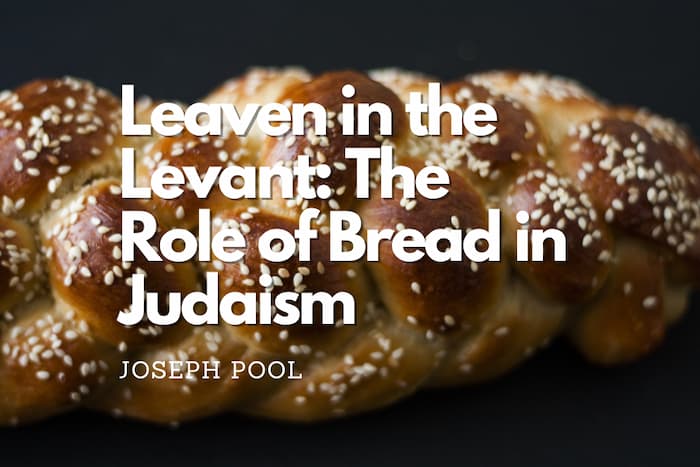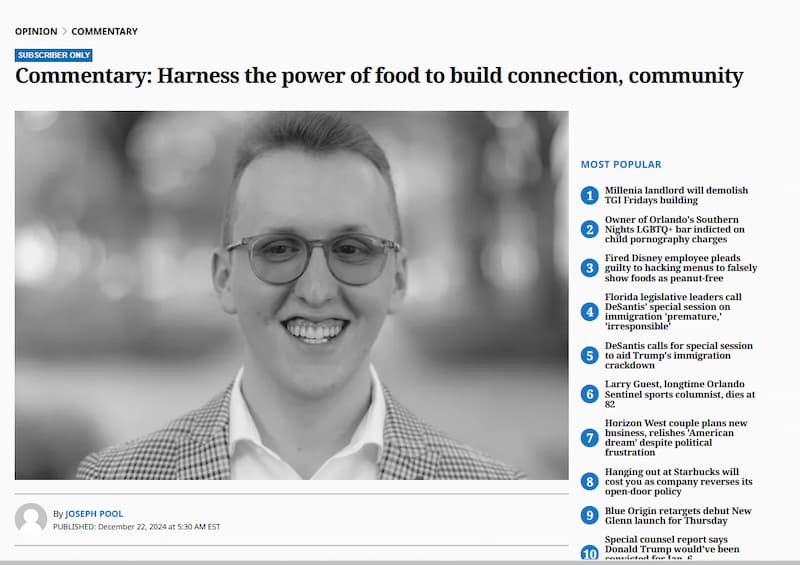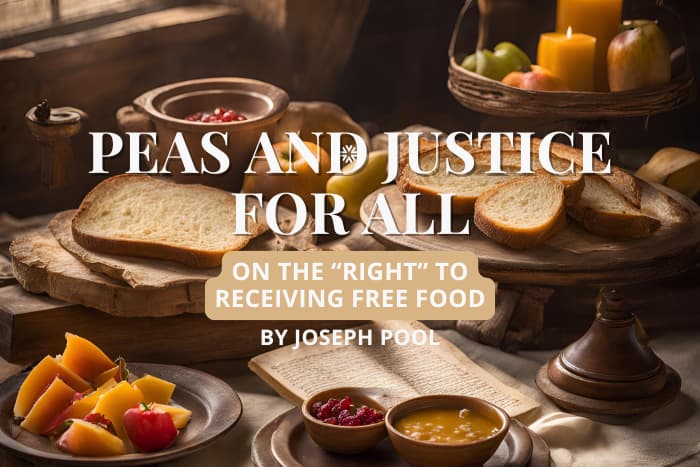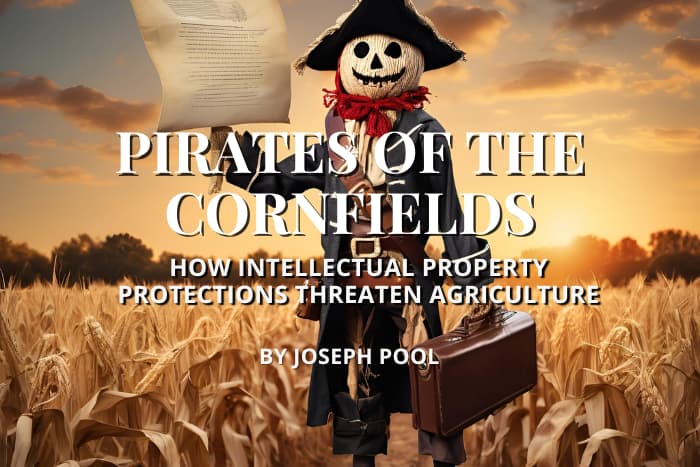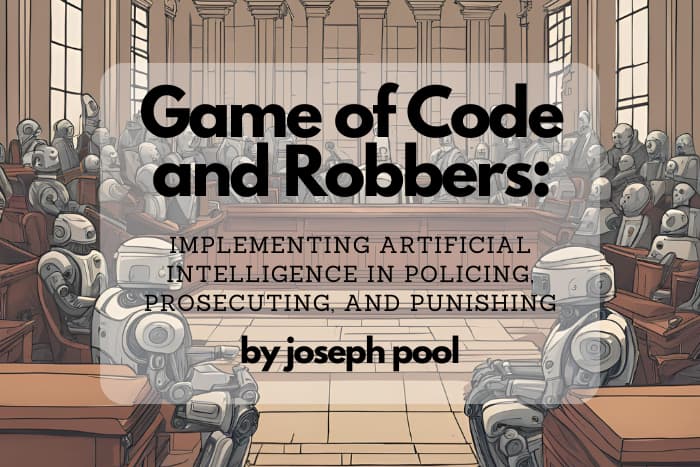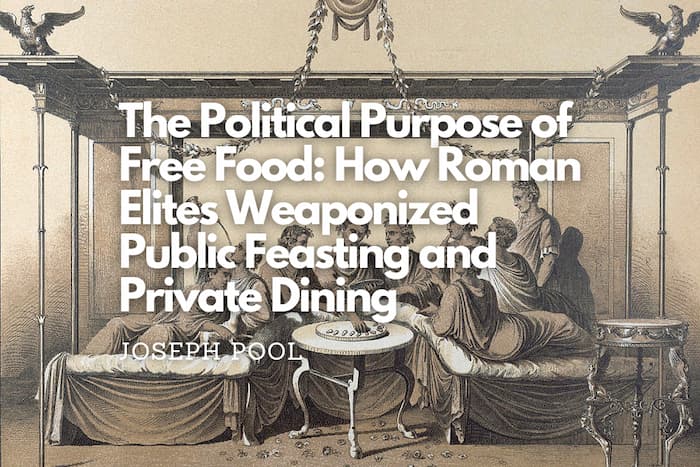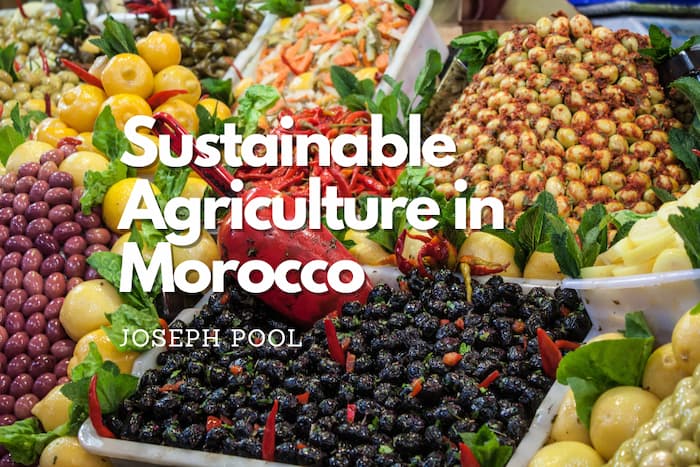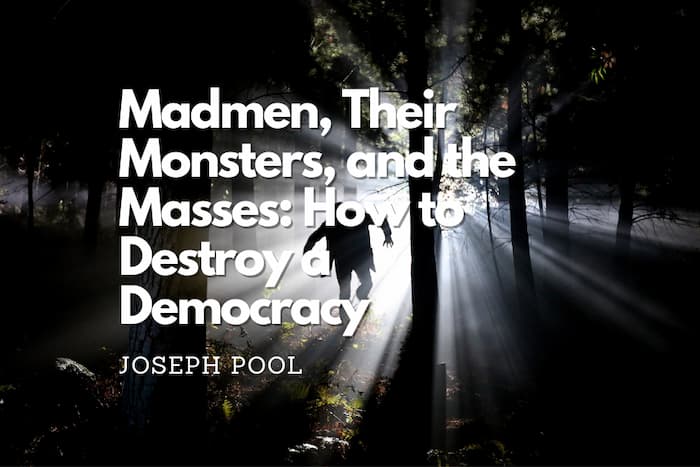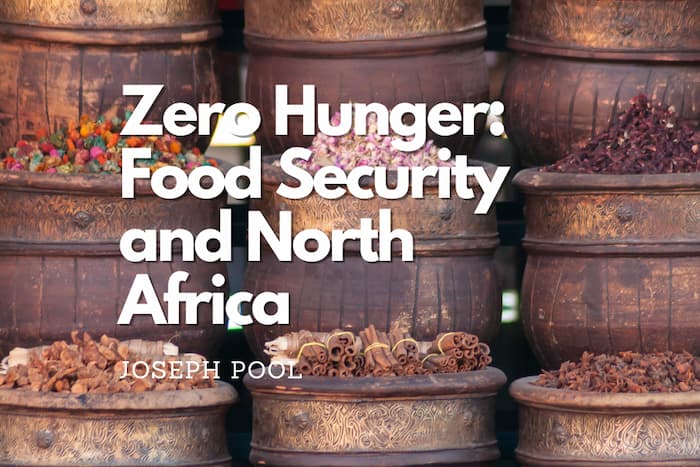Joseph Pool
INTRODUCTION
If one were to combine flour, water, and heat in just the right ratio at just the right time, their efforts would be rewarded with fresh bread—a sacred staple of societies for thousands of years, visible across nearly all ancient cultures. This bread, however, is more than a source of carbohydrates and calories; it is a catalyst for the cultivation of culture and complex belief systems. Throughout history, food, specifically bread, has given rise to religious practices, and in the modern world, the ceremony surrounding the preparation and eating of bread serves as a continued symbol of ancient values and belief systems to their adherents. It allows for members of religious rites to gain physical sustenance while maintaining a spiritual identity. While referenced across many cultures and a staple of survival to people around the world, bread plays a uniquely oversized role in the foodways and religious doctrines and practices of Judaism.
In Judaism, the rain of miraculous “manna” bread in the Exodus story serves as proof of God’s continued protection and providence. It rewards faith in God and those who followed Moses. It also serves as easily-digestible lessons in morality and virtuous living. By baking “challah” bread, people reaffirm their faith and values, and pass it on to future generations. Alternatively, the continued use of “matzah” bread at Passover seders around the world serves as an annual reminder of past oppression and encourages continued religious and ritualistic adherence to Judaism and its values of making the world a better place. Beyond any other food, bread allows for religious beliefs to be continually conferred onto communities and for connections between the past, present, and future to be repeatedly reinforced. This paper will explore bread’s role as a sustainer of people and religions through historical and textual analysis to explain bread’s ancient roots, sociological explanation of its importance to communities, and finally with an anthropological lens to see how bread has shaped human belief.
BAKED INTO OUR BEGINNING
Bread is a food laden with symbolic meaning and frequently referenced in daily conversations and friendly discourse. Bread is a common reference used in figurative language and popular expressions. People often defend the reason they spend long hours away from home as working in order to “put bread on the table.” As a way of expressing happiness with and appreciation of something, people endearingly call it the “greatest thing since sliced bread.” On the other hand, things that are routine are someone’s “bread and butter.” In recent years, the term “let’s get this bread” has become a colloquialism used by people working on accruing wealth—itself known as “dough.” The growing field of culinary diplomacy in international and intercultural relations makes use of the idea of sitting down and “breaking bread” together. The list goes on. All of these phrases go a long way to establishing bread’s place at the table, literally and figuratively. In these phrases, bread is used as a symbol of success, stability, and happiness, regardless of the form that may take. As it relates to historical cultures and beliefs, bread plays a similar semiotic role. To understand the significance of bread in religious practices and foodways, one must first ascertain how it rose to prominence and helped to sow the seeds of civilization at large. One must begin by understanding the start of cities and advanced societies, aided in no small part by the cultivation of grains and the baking of the first forms of bread.
In his book, A History of the World in 6 Glasses, Tom Standage divides human history into six major periods, each of which he connects to the beverages that helped establish them and defined them. Discussing the first of these beverages—beer, and its role in catalyzing the transition of people from hunter-gatherer groups to agrarian cities, he discusses the pivotal role played by grains and the discovery of bread. He notes that, “Throughout the Fertile Crescent there is archeological evidence from around 10,000 BCE of flint-bladed sickles for harvesting cereal grains, woven baskets for carrying them, stone hearths for drying them, underground pits for storing them, and grindstones for processing them … the ability to store cereal grains began to encourage people to stay in one place,” (Standage, 2006, p. 13). As early as 10,000 BCE, great care was taken by semi-nomadic groups to efficiently harvest and prepare these cereal grains due to the fact that they “could be stored for consumption months or even years later, if kept dry and safe … When no other foodstuffs were available to make soup, they could be used on their own to make either a thick porridge or a thin gruel. ” (Standage, 2006, p. 12) The ability to have a reliable, resistant, and filling food source led to the once-nomadic groups settling in certain areas to continue and cultivate these crops. Bread, and the cereal grains that comprise it, are thus directly responsible for the advent of cities and civilizations. They led to the first settlements and with them, the ability for people to think about bigger ideas than surviving through the night. With time to think and concerns about sustenance no longer critical, people started to wonder where they came from and what they were meant to do. Religious and spiritual practices emerged with answers to these questions and provided people with newfound meaning. As Jared Diamond explains in his book, Guns, Germs, and Steel, “Stored food can also feed priests, who provide religious justification for wars of conquest; artisans such as metalworkers, who develop swords, guns, and other technologies; and scribes, who preserve far more information than can be remembered accurately,” (Diamond, 1997, p. 90). In the beginning, cereal grains and bread played a role in starting religious tales and allowing for them to be recorded and passed along.
In the first chapter of Genesis, the Torah recounts, “And from the ground God caused to grow every tree that was pleasing to the sight and good for food, with the tree of life in the middle of the garden, and the tree of knowledge of good and bad,” (Genesis, 1:9). From its first mention, food is placed right alongside man both in the story and the garden. It is written as grown by God directly and alongside, the ideas of life, knowledge, good, and bad. How could food not be linked to religious and philosophical questions when its first mention connects it with ideas of morals and beliefs. The mentions of food and its connection with pivotal moments in the Bible continue on. As Harriott Chick recounts, “When Abraham (about 2000 B.C.) was visited by three angels unawares, he commanded Sarah to ‘make ready quickly three measures of fine meal, knead it, and make cakes upon the hearth’ (Genesis, 18,6). The word ‘knead’ suggests the formation of a dough and the mention of leaven when Lot made a feast hurriedly for the two angels who met him in the gate of Sodom and ‘did bake unleavened bread’ (Genesis, 19,3) is evidence that the meal used was wheaten meal.” Bread serves as the food of hospitality in early religious stories and is proudly presented to guests, whether divine angels or wandering strangers. Its proper preparation, seen by Sarah kneading it upon the guests’ arrival, and the respectful presentation of it, seen by Abraham taking care of the guests’ needs, serve to inform these guests of the quality of their hosts. In these stories, bread plays a semiotic role.
As encapsulated by Vatika Sibal, “The role of food in religious culture is an important part of showing respect among their communities … What we consume, how we acquire it, who prepares it, who’s at the table, and who eats first is a form of communication, that is, it has a rich cultural base. Beyond merely nourishing the body, what we eat and with whom we eat can inspire and strengthen the bonds between individuals, communities, and even countries,” (Sibal, 2018). Bread has been baked into the fabric of societal interactions from promoting religious practices to hosting providing for passersby. Bread has served and continues to serve as a symbol of these ideas and a practical, edible manifestation of religious beliefs and foodways. This is evident especially in Judaism—through manna, challah, and matzah.
More than any other food item, bread plays a massive role in Jewish lifestyle and practices. It is given such an honor, in fact, that according to Jewish law, a meal is only a meal if a certain amount of bread is consumed during it. Otherwise, the meal is relegated to the status of a snack. This fact enforces the idea that bread, more than meats or dairy or any other food item, is what carries the importance during a meal. Unlike all other foods which are blessed based on very broad categories—pri hagafen for fruits of the vine, pri haetz for fruits of the tree, pri haadama for fruits of the ground, minei mezonot for grains, and shehakol for other foods—bread is given its own blessing. In this special prayer, hamotzi lehem, God is praised as the One who “brings forth bread from the Earth.” Not grains or crops or a category of food—just bread. According to Jewish law, bread receives another distinction: only a true meal with bread warrants the recitation of grace after meals. As David Freidenreich summarizes, “Bread is significant stuff. Bread was so central to the ancient Near Eastern diet that the Hebrew word lehem serves as a metonym for food itself,” (Freidenreich, 2012). From Jewish law alone, the preeminence of bread is obvious to all, and its role in providing spiritual and physical sustenance is above any other.
MORALITY THROUGH MANNA
In a Biblical context, bread was a catalyst through which divine morals, beliefs, and laws were transferred onto the Jewish people. This is seen in the case of manna, the divinely-provided bread that kept the Jews alive as they traveled the desert from Egypt to what would be Israel. This manna bread, however, did much more than service the hunger of a hungry people, it acted a symbol and conferred complex ideas upon them. It was a sign from above. As explained by the Stanford Encyclopedia of Philosophy and its discussion of the works of Charles Sanders Peirce, “Peirce’s Sign Theory, or Semiotic, is an account of signification, representation, reference and meaning,” (Atkin, 2012). Similarly, bread allowed for an easy reference to divine providence and signified the abilities of God to provide something from nothing; bread was the medium that showed to the people God’s unique ability to engage in acts of creation. Some of the fundamental beliefs of the Jewish religion were evidenced by the story of the manna. Lessons in virtues and morals were present as well.
In the story of the manna, God informs Moses, ““I will rain down bread for you from the sky, and the people shall go out and gather each day that day’s portion—that I may thus test them, to see whether they will follow My instructions or not. But on the sixth day, when they apportion what they have brought in, it shall prove to be double the amount they gather each day,” (Exodus, 16:4-5). Within the wording of the Torah itself, God makes apparent his desire to “to see whether they will follow My instructions or not.” Bread is transformed into a gauge of the peoples’ willingness to follow simple instructions and a probe into if they will be capable of receiving more important, intricate ones. Bread, a food known to man since Adam and Eve and symbolic of hospitality since Abraham, had now become a cornerstone of Judaism. By accepting this bread, they were accepting the future obligations that came with it. They were acknowledging a belief in a creator God—one who could make bread materialize from nothing—and a willingness to adhere to God’s divine laws.
The rules were made clear as, “Each household shall gather as much as it requires to eat—an omer to a person for as many of you as there are; each household shall fetch according to those in its tent,” (Exodus, 16:15-36). The virtue of moderation was extolled and the idea of taking what is needed, not more or less, was conferred as the proper way to act. The people were instructed to eat the food by morning, requiring them to put aside human fears of not finding food the next day and to fully rely on God’s provisions. The consequences for gluttony or a lack of faith were also made clear. The Torah recounts, “But they paid no attention to Moses; some of them left of it until morning, and it became infested with maggots and stank. And Moses was angry with them,” (Exodusu, 16:20).
Besides lessons about moderation, appreciation, and reliance on the divine, the manna bread was the way in which the Jews practiced one of the tenets of Jewish tradition: observance of the Shabbat, a biblically-ordained day of rest. Moses commands, “Tomorrow is a day of rest, a holy sabbath of God … Six days you shall gather it; on the seventh day, the sabbath, there will be none.” Shabbat is a day in which Jews’ faith is tested. They are instructed to refrain from work, or collection of bread, and must trust that God will be there to provide them with sustenance and stability. By following Shabbat—by not collecting the manna—the Jewish people are putting aside basic human needs and worries, and instead focus on the spiritual. Bread was and is the way in which Jewish lessons of faith and morality were conferred. Every Shabbat observed to this day reflects that original refrain from collecting bread and signifies a continued commitment to following God and the laws expressed by the Torah. To this day, manna is remembered.
CONTINUITY THROUGH CHALLAH
According to the Encyclopedia of Religion and Society, orthopraxy is defined as “the proper performance of religious duties, largely ritual in character,” (Swatos, 1998). Observant Judaism is considered a religion of orthopraxy. More than the words one reads or laws that they learn, the actions they do and the proper intent behind them matter. In Jewish law, this orthopraxy is based on 613 mitzvot, also known as divine obligations. Many relate to bread, its proper preparation, its proper blessings, and its proper eating. Once again, bread plays a role in bridging the physical and practical with the spiritual and special. Just as water and cereal grain bind together to create bread, bread itself binds people and practices together. This is especially observable in the case of challah bread, the priestly portion.
To this day and as expected by Jewish law, Jews around the world prepare two loaves of challah bread for the Shabbat every week. While different places and peoples have different customs relating to the name, shape, size, and way to make the bread, the same ideas are present throughout. This bread, eaten weekly in nearly all continents, encapsulates many of the beliefs paramount to Judaism. For one example, the two loaves serve as a semiotic index for the double portion of manna bread that the Jews received in the Exodus narrative. By baking it before the start of the sabbath, there is a reaffirmation of faith in God’s ability to provide and a continued commitment to honoring the day of rest—itself a duty so important it comprises one of the 10 Commandments. Through an unbroken chain over the course of millenia, the commitment of the Jewish people to their laws and values is repeatedly tested.
Another duty related to this bread connects it to manna bread’s lessons of gluttony and expands it to the ethicality of sharing. This commandment, known as terumat challah, refers to a two-part obligation: first, to give the first of the dough as an offering to God, and second, to give a portion of one’s bread to the Kohanim, the Jewish priest caste. As it relates to ethical eating, “Breaking and sharing bread is hereby elevated as the essential gestures of hospitality. Sharing bread becomes so enmeshed with hospitality that, at least for the early rabbis, it may be demanded from any host, even from royalty themselves,” (Crane, 2017). Sharing one’s bread is the way in which they show gratitude and grace towards others. According to Krystal D’Costa, “Making bread is work, after all: you have to cultivate, harvest, dehusk, and grind the cereal grains, and then knead and bake the dough which necessitates the building of a fireplace or oven. This requires time and commitment,” (D’Costa, 2018). It is for this reason that bread is the food of Shabbat, the food of meals, and the food of hospitality. To prove their morality, one gives up a portion of their time and handiwork to someone else, whether God, a priest, or a stranger.
By continually baking two loaves of challah and sharing it with others, Jews are able to continually confer their teachings on future generations and preserve their biblical history. While time consuming to make, the end result is something enjoyed by everyone at the table and in a way, rewards adherence to Jewish customs and laws. Like the double portion of manna bread that rained before the Shabbat, the double loaves of challah allow for lessons of sharing with others and caring for others to be taught and physically internalized. With these morals and values baked in, bread enables Jewish people to learn and teach another lesson, often considered the defining value of Judaism: tikun olam, repairing the world.
ADVOCACY THROUGH MATZAH
As explained by Sefaria.org, “Matzah is the unleavened bread made from any of the five grains mentioned in Torah: wheat, barley, spelt, rye, and oats. In the Torah, Jews were commanded by God to eat matzah before leaving Egypt and today are obligated to eat matzah during the Passover Seder.” During the Exodus narrative, the Jews had to leave the land of Egypt in haste. It is specifically mentioned that they had no time to make properly leavened bread for the journey. “And they baked unleavened cakes of the dough that they had taken out of Egypt, for it was not leavened, since they had been driven out of Egypt and could not delay; nor had they prepared any provisions for themselves,” (Exodus, 12:39). Similarly to manna and challah, the unleavened matzah bread is filled with meaning and messaging. It serves as a tool to remind the Jewish people that they were slaves who did not have the luxury of baking bread and had the requirement to work in brutal conditions. In a poetic way, the weekly Shabbat now encourages them to bake bread and requires them to refrain from work. It is this matzah-induced notion, of slavery to freedom, that has led to Jewish advocacy around the world. Bread has given rise to the modern interpretation of repairing the world, an interpretation that requires active advocacy for equality and morality under the watch of God.
Matzah itself is considered the “bread of affliction” and every bite of it during the symbol-rich seder is expected to remind the Jews of their past compared with their present. Instead of beautifully-baked challah bread, they have unassuming, unflavored, unleavened bread. The role of bread is so imbued within Judaism that the entire holiday of Passover, celebrating the quintessential story of slavery to one of freedom and redemption, is known as the Festival of Matzah. Jews eat the matzah not to merely focus on the past but to connect it with the present. According to Sefaria.org, the special prayer book used on the holiday of Passover states, “We were slaves to Pharaoh in the land of Egypt. And the Lord, our God, took us out from there with a strong hand and an outstretched forearm.” It is incumbent upon Jewish people to annually recite this story of salvation from slavery and relive the trials and tribulations faced by their ancestors in a far away land. In the modern day, the ideas communicated by matzah have led to the rallying cry of tikun olam being used to unite people for a common cause.
According to the Religious Action Center, “During the Civil Rights Movement, Jewish activists represented a disproportionate number of white people involved in the struggle. Jews made up half of the young people who participated in the Mississippi Freedom Summer in 1964. Leaders of the Reform Movement were arrested with Rev. Dr. Martin Luther King, Jr. in St. Augustine, Florida, in 1964 after a challenge to racial segregation in public accommodations. Most famously, Rabbi Abraham Joshua Heschel marched arm-in-arm with Dr. King in his 1965 March on Selma,” (rac.org). Matzah is a constant reminder of the change from slavery to freedom and serves as a spark for Jews, and others who wish to adopt the idea, to get involved in the world around them and, as Lawrence Fine states, “seek to relieve the suffering of all people in need, regardless of religion, ethnicity or nationality,” (Fine, 2018).
Tikun Olam is viewed as the all-encompassing, end goal of Judaism. This goal is one represented throughout Jewish foodways. To engage in tikun olam involves a complex understanding of morality, a continued acceptance of God and faith in the divine, and a commitment to turning doctrine into practice. Along every step of this journey, bread reinforces these ideas and acts as a physical manifestation of them. To Abraham, bread was the symbol of hospitality and openness to strangers. To Joseph, bread was the sign of forgiveness and graciousness to the brothers that sold him into slavery. To the Jews in the desert, manna was a manifestation of God’s protection and the rules about when and how to collect it were previews of what would become the laws in a religion of orthopraxy and proper living. To this day, the baking and breaking of challah bread informs those around and God above that all who do it still happily accept the commandments and have continued millenia old traditions. Ideas of the importance of sharing and providing for others are conveyed through it. Finally, the annual recitation of the Passover narrative and observance of the Festival of Matzah, encourage Jews to take the next step and turn the symbol that bread represents into tangible action. It is incumbent upon the Jewish people to continue engaging in the charge of changing the world, inspired by the bread of the Biblical narratives and the bread they themselves bake every week.
CONCLUSION
In the beginning, bread helped to sow the seeds of society. It allowed for people to go from hunter-gatherers worrying about their immediate needs to settlers creating the first cities in which people had enough sustenance and food security to wonder about the world around them. Bread has an oversized, overproofed role in world development and takes various forms across many cultures. As Krystal D’Costa remarks, “Indians have roti, naan, paratha, and daal puri. Armenians have lavash. Ethiopians have injera. The French have the boule, brioche, and baguette. The British have scones. And the Polish have challah. These are but a few of the different types of breads that are enjoyed around the world,” (D’Costa, 2018). Bread serves as a food of sustenance but also as a foundation of spirituality. Judaism is a religion in which bread has been baked into nearly all the core tenets of belief.
For eating of the forbidden fruit—believed by some to actually be wheatberries—Adam is punished with working for bread. God curses him, “By the sweat of your brow Shall you get bread to eat, Until you return to the ground— For from it you were taken. For dust you are, And to dust you shall return,” (Genesis, 3:19). Bread is so significant that the punishment for the original sin is having to work hard in order to make it. From there, bread is adopted by Abraham as a way of honoring guests and receiving divine messengers. It becomes a tool of gratuity and graciousness. When the Jews flee Egypt, the manna that rains down on them provides proof of God and allows them to digest the complex responsibilities and ethical implications of freedom. To this day, the eating of matzah reminds Jews that freedom comes with the obligation to ensure that others are granted the same. Challah is prepared and shared with guests to connect the stories of Abraham, Moses, and the present. Ancestors and stories of old are united with descendents and social identities of new. Bread nourishes this connection by nourishing all those who share it in a communal, religious meal. As a final testament to bread’s role in Judaism, a meal only begins when bread is present and only ends when God is praised for providing it.
REFERENCES
A brief history of jews and the Civil Rights Movement of the 1960s. Religious Action Center of Reform Judaism. (n.d.). Retrieved May 3, 2023, from https://rac.org/issues/civil-rights-voting-rights/brief-history-jews-and-civil-rights-movement-1960s
A living library of jewish texts online. Sefaria. (n.d.). Retrieved May 2023, from https://www.sefaria.org/
Atkin, A. (2022, August). Peirce’s theory of signs. Stanford Encyclopedia of Philosophy. Retrieved May 2023, from https://plato.stanford.edu/entries/peirce-semiotics/
Bread. (2017). In Food, feasts, and faith: An encyclopedia of food culture in world religions: A–K, 73-77.
Benett, P. (2014). Turning stones into bread: Developing synergistic science/religion approaches to the world food crisis. Zygon: Journal of Religion and Science 49(4), 949-957.
Berman, L. (n.d.). “taking” Challah as an act of giving. Sefaria. Retrieved May 2023, from https://www.sefaria.org/sheets/363402?lang=bi
Chick, H. (1958). Wheat and bread. A historical introduction. Proceedings of the Nutrition Society 17(1), 1–7. doi:10.1079/PNS19580003.
Diamond, J. (1998). Guns, germs and steel. Vintage.
D’Costa, K. (2018, July 24). Our 14,400-year-old relationship with bread. Scientific American. Retrieved from https://blogs.scientificamerican.com/anthropology-in-practice/our-14-400-year-old-relationship-with-bread.
Exodus. Sefaria. (n.d.). Retrieved May 2023, from https://www.sefaria.org/Exodus
Fine, L. (2018, November). What is Tikkun Olam? Pittsburgh inspires call to ‘fix’ world. Time. Retrieved May 2023, from https://time.com/5441818/pittsburgh-tikkun-olam-history/
Freidenreich, D. M. (2012). Contextualizing bread: An analysis of talmudic discourse in light of Christian and Islamic counterparts. Journal of the American Academy of Religion 80(2), 411-33.
Genesis. Sefaria. (n.d.). Retrieved May 2023, from https://www.sefaria.org/Genesis
Hansen, B. (2021). Bread in the desert: The politics and practicalities of food in early Egyptian monasticism.” Church History 90(2), 286-303.
Sibal, V. (2018). Food: Identity of culture and religion. Retrieved May 2023, from https://www.researchgate.net/publication/327621871_FOOD_IDENTITY_OF_CULTURE_AND_RELIGION
Standage, T. (2007). A history of the world in 6 glasses. Atlantic Books.
Swatos, W. H. (1998). Orthopraxy. Encyclopedia of Religion and Social Science. Retrieved May 2023, from http://hirr.hartsem.edu/ency/Orthopraxy.htm
